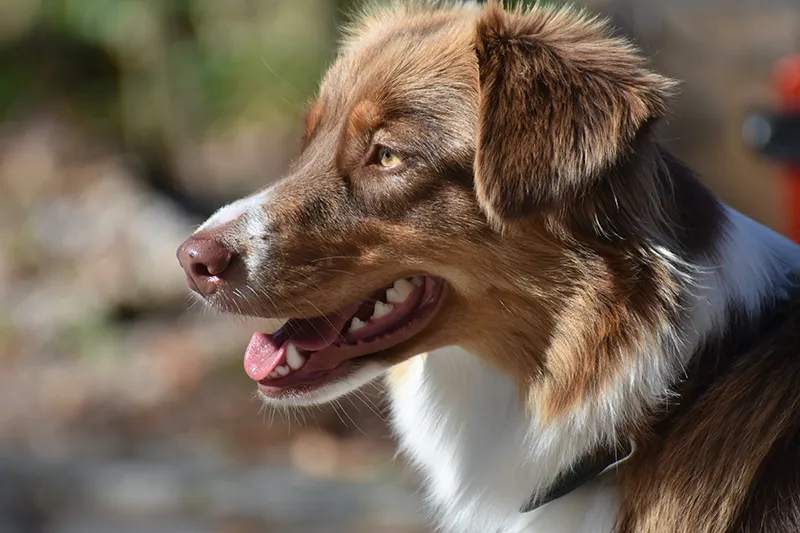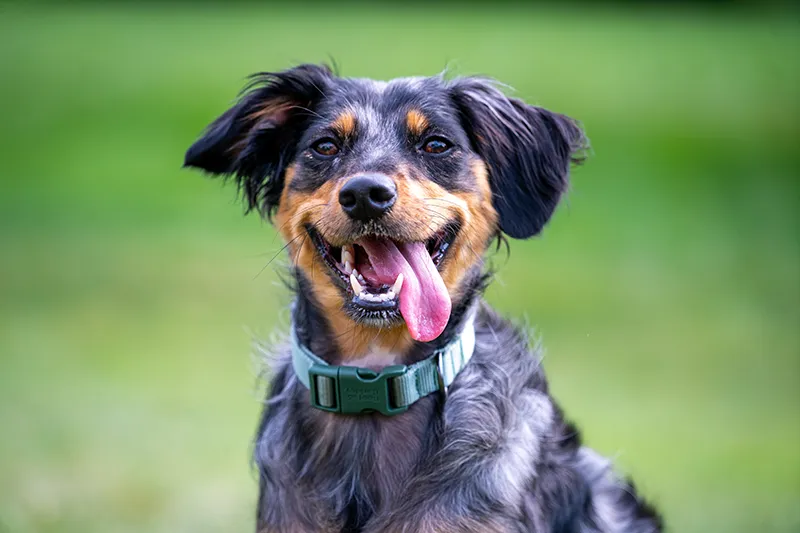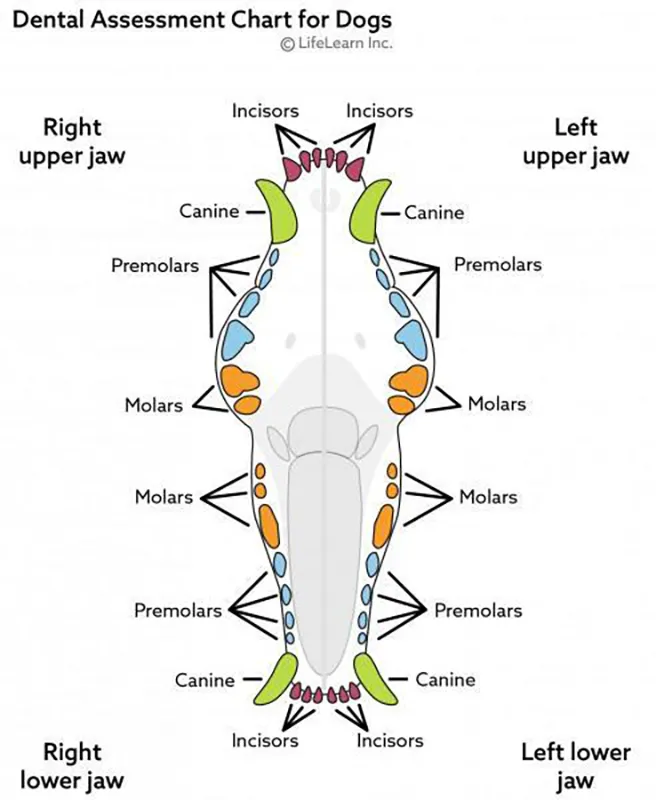
How common is dental disease in dogs?
Dental disease is one of the most common medical conditions seen by veterinarians. Over 80% of dogs over the age of three have active dental disease.
Few dogs show obvious signs of dental disease, so it is up to the dog’s family and veterinarian to uncover this hidden and often painful condition.
Are dental problems the same in pets and people?
Dogs can get many of the same or similar oral diseases as are seen in people. However, whereas the most common dental disease in people is tooth decay or cavities, in dogs it is periodontal disease. Whether someone develops cavities or not depends on multiple factors including environmental, bacterial plaque, and diet, but ultimately, there is tooth decay.
In dogs, tooth decay is rare representing less than 10% of all dental problems. The most common dental problems seen in dogs are periodontal disease and fractured teeth.

What is periodontal disease?
Periodontal disease is a term used to describe infection and associated inflammation of the periodontium (the tissues surrounding the tooth). Specifically, there are four tissues that make up the periodontium. They are the gingiva, the cementum (covering of the root surface), the periodontal ligament (the ligament attaching the tooth root to the bone) and the alveolar bone. Periodontal diseases begin with gingivitis and left untreated, the infection often spreads deeper into the tooth socket, destroying the bone. Ultimately, the tooth becomes loose and may fall out over time.
Is periodontal disease very common?
It is estimated that more than two-thirds of dogs over three years of age suffer from some degree of periodontal disease, making it the most common disease affecting pet dogs.
How does tartar form and why is it a problem?

Can plaque and tartar be prevented?
The rate at which plaque becomes mineralized is much quicker in some dogs than in others.
The best way to prevent tartar build-up is through daily tooth brushing using a toothpaste that is specifically formulated for dogs and is designed to be swallowed. Unfortunately, even though it is the best form of plaque control, most dog owners do not brush their dog’s teeth daily.
Special dog chew toys and treats may also help reduce or delay plaque and tartar build-up. Some pet foods have been specifically formulated as dental diets that mechanically and/or chemically assist in plaque removal. Water additives are also available.
The Veterinary Oral Health Council evaluates dental products for effectiveness and their seal of acceptance will only be found on products which have been shown to reduce the accumulation of plaque and/or tartar. You can visit their website (vohc.org) for a list of plaque control products. Your veterinarian can help you decide which options are right for your dog.
Will feeding dry food remove tartar?
Pet food manufacturers have developed dental diets that can help reduce the formation of plaque and tartar on your dog’s teeth. Once tartar has formed, however, professional scaling and polishing under general anesthesia will be needed as it cannot easily be removed by diets and/or brushing.

What is involved with a routine dental cleaning?
A routine dental cleaning involves a thorough dental examination, followed by a dental scaling and polishing to remove the plaque and tartar from all tooth surfaces. Your veterinarian will perform pre- anesthetic blood tests to ensure that kidney and liver function are satisfactory for anesthesia. Sometimes antibiotic treatment is started before the periodontal therapy is performed. Your veterinarian will discuss the specific recommendations for your pet.
Once your dog is anesthetized, your veterinarian will thoroughly examine his mouth, noting the alignment of the teeth and the extent of tartar accumulation both above and below the gumline. Intraoral radiographs (X-rays) to assess the viability of the tooth root and surrounding bone should also be performed. If periodontal disease is severe, it may not be possible to save the affected teeth. Depending on the affected tooth, extraction may be the only option. Next, tooth scaling will be performed using both traditional hand scalers and ultrasonic cleaning equipment to remove all traces of tartar, both above and below the gum line.
“After scaling, the teeth are polished to remove microscopic scratches that occur during scaling.”
After scaling, the teeth are polished to remove microscopic scratches that occur during scaling. A smooth surface on the tooth is essential to prevent plaque from easily sticking to the tooth’s enamel. Special applications such as fluoride, antibiotic preparations, and cleaning compounds may be indicated to decrease tooth sensitivity, strengthen enamel, treat bacterial infection, and reduce future plaque accumulation. Additionally, depending on the importance of the tooth in question and the type of periodontal disease present, guided tissue regeneration and or guided bone regeneration (GTR/GBR), which are more advanced periodontal procedures, may be possible with referral to a board-certified veterinary dentist.
What do broken, chipped, or fractured teeth look like in dogs?
The center of the tooth, called pulp, is covered by hard dentin and even harder enamel.
There are two types of tooth fractures that involve the crown of the tooth. Uncomplicated fractures expose sensitive dentin. Complicated crown fractures involve not only the dentin, but extend even deeper to expose the pulp, which contains nerves and blood vessels.
What causes fractured teeth in dogs?
Most tooth fractures occur when dogs chew on objects that are too hard, like ice cubes, bones, hard nylon chews, antlers, and horse and pig hooves. Any chew toy or dental treat fed to a dog should bend and “give” upon compression.
What is done to treat fractured dog teeth?
If the pulp is exposed, root canal therapy or extraction of the tooth are the only treatment options. Leaving the tooth without treatment is not a good idea, as infection will have direct entry through the fracture site and a more serious infection is likely to occur (see the handout “Does My Dog Need a Root Canal?” for more information).
With gentleness, patience, and perseverance you can provide the oral care your dog needs to prevent dental disease. Ask your veterinary healthcare team for advice and guidance for teeth brushing tips.
HEAL Veterinary Hospital
25 Jay Street
Brooklyn, NY, 11206
t: 929-359-9297
Also serving Dumbo Brooklyn, NY and surrounding areas.
Business Hours
Monday-Friday: 9am–5pm
Saturday: 9am–3pm


